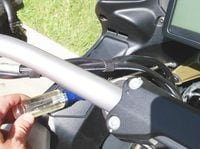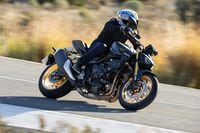It’s the little things in motorcycling that I find swing my emotions. You know that feeling of riding a bike other than your own when you try to reset the trip meter, and it makes you want to jump off a building? (I’m looking at you, MV Agusta). By the same token, I find great joy in the feeling of utilizing a component on the motorcycle that works properly. BMW saddlebags come to mind, or adjusting tire pressure on Triumphs that use those superb 90-degree valve stems.
Among these relatively mundane "thrills and spills," sport-touring bikes are often the worst offenders. There are so many bells, whistles, and do-dads to fiddle and adjust that there are bound to be frustrations. My long-term Multistrada is not without these frustrations. The arm used to deploy the centerstand hits the back of my left foot when I ride, for example, and it has become the tactile equivalent of fingernails on a chalkboard to me.
Simpler ways to adjust headlights exist in the motorcycling world, but they are few and far between. These four bolts used to adjust the Multi's beams are conveniently places and easy to use. Bellissimo!
So when it came time to adjust the headlights down, I thought I might be in for about an hour of skinned knuckles and annoying fasteners, digging through layers of bodywork in search of adjustment bolts. No. As it turns out, the boys in Borgo Panigale are way ahead of me. Four galvanized bolt heads are visible in front of the triple trees, one each for lateral and vertical adjustment on the two assemblies.
With the headlights on and pointed at a wall or dark surface, a Philips-head screwdriver of appropriate length is the only thing standing between you and perfectly level beams. No annoying fasteners, no skinned knuckles. This represents an enigma in motorcycling that we all deal with. How is it that headlight adjustment can be made so perfectly simple while a centerstand tab can be so infuriating? (And all without the complexity of electric motors to move the reflectors.)
Each bike comes down to a compromise of these factors. We choose a motorcycle based on broad and important metrics like power, luggage space, fuel capacity, or wind protection. But it’s when we become intimately familiar with a bike that we really bond with it and discover whether its list of idiosyncrasies matches our own quirks and neuroses.
This Multi has its share of things that bother me; the centerstand, which I already mentioned, but also the finicky saddlebags, and the ever-inferior digital tachometer, to name a few. These represent design choices Ducati made that I wouldn't have, but perhaps they're made for reasons not obvious to me. You think the extra latches on the saddlebags are the result of some Ducati test rider leaving his gear all over the Autostrada? Plausible.
For each of those annoyances, though, there are five things that I love. When I accelerate up an on-ramp and the front tire skims along the ground in the first three gears, I smile a little wider. When I adjust the wind protection in a matter of seconds by sliding the screen up or down and locking it with one hand I can’t imagine why every other company doesn’t just copy the design. (A friend of a friend who bought a 2012 Multi is intensely jealous of this simple, elegant feature.) And now I'll add adjusting the headlights to that list, because Ducati has made it absolutely as easy as it needs to be.
I could go on explaining the little things that tickle me about my first long-termer, but there is one feeling that describes them all. After long hours on the interstate I gas up, reset the trip meter, and when I realize I’m still excited to get on this bike I know that the Multi and I are an ideal match.
That feeling is a little harder to describe, and I think it’s best if I don’t try.












/cloudfront-us-east-1.images.arcpublishing.com/octane/2WF3SCE3NFBQXLDNJM7KMXA45E.jpg)
/cloudfront-us-east-1.images.arcpublishing.com/octane/G4MG6OUCJNBSHIS2MVVOTPX65E.jpg)
/cloudfront-us-east-1.images.arcpublishing.com/octane/IIGGWFOTOJGB7DB6DGBXCCMTDY.jpg)
/cloudfront-us-east-1.images.arcpublishing.com/octane/QSTCM6AVEZA5JJBUXNIQ3DSOF4.jpg)
/cloudfront-us-east-1.images.arcpublishing.com/octane/U4I7G625B5DMLF2DVIJDFZVV6M.jpg)
/cloudfront-us-east-1.images.arcpublishing.com/octane/B6XD6LS6IVCQPIU6HXDJSM3FHY.jpg)
/cloudfront-us-east-1.images.arcpublishing.com/octane/ICL63FEDDRDTTMINYICCEYGMDA.jpg)
/cloudfront-us-east-1.images.arcpublishing.com/octane/FCGZHQXRBZFLBAPC5SDIQLVF4I.jpg)
/cloudfront-us-east-1.images.arcpublishing.com/octane/WNOB6LDOIFFHJKPSVIWDYUGOPM.jpg)

/cloudfront-us-east-1.images.arcpublishing.com/octane/X33NU3E525ECRHXLNUJN2FTRKI.jpg)
/cloudfront-us-east-1.images.arcpublishing.com/octane/6KKT5NNL2JAVBOXMZYS5ZO76YA.jpg)
/cloudfront-us-east-1.images.arcpublishing.com/octane/J5RKG5O455GMPGQRF2OG6LRT7A.jpg)
/cloudfront-us-east-1.images.arcpublishing.com/octane/GX2CIZKQVRH2TATDM26KFG2DAE.jpg)
/cloudfront-us-east-1.images.arcpublishing.com/octane/ZWIDYSAKQZHD5BHREMQILXJCGM.jpg)
/cloudfront-us-east-1.images.arcpublishing.com/octane/CYUHJZCTSJCH3MRAQEIKXK7SCQ.jpg)
/cloudfront-us-east-1.images.arcpublishing.com/octane/LKOFINY56FCXJCANJ5M7ZDQUBY.jpg)
/cloudfront-us-east-1.images.arcpublishing.com/octane/4NBPDACMWJH63JQYJVK3QRBDZI.jpg)
/cloudfront-us-east-1.images.arcpublishing.com/octane/KKHQHRR3FJGX7H2IPU6RALMWG4.jpg)

/cloudfront-us-east-1.images.arcpublishing.com/octane/5IOFS5JAE5FOXMNA23ZRAVVYUU.jpg)
/cloudfront-us-east-1.images.arcpublishing.com/octane/CGXQ3O2VVJF7PGTYR3QICTLDLM.jpg)

/cloudfront-us-east-1.images.arcpublishing.com/octane/OQVCJOABCFC5NBEF2KIGRCV3XA.jpg)